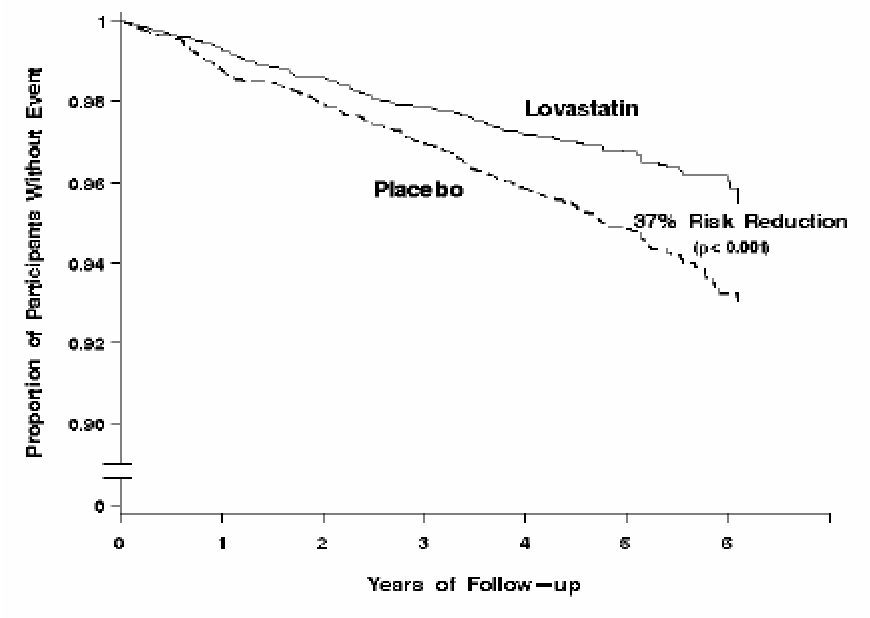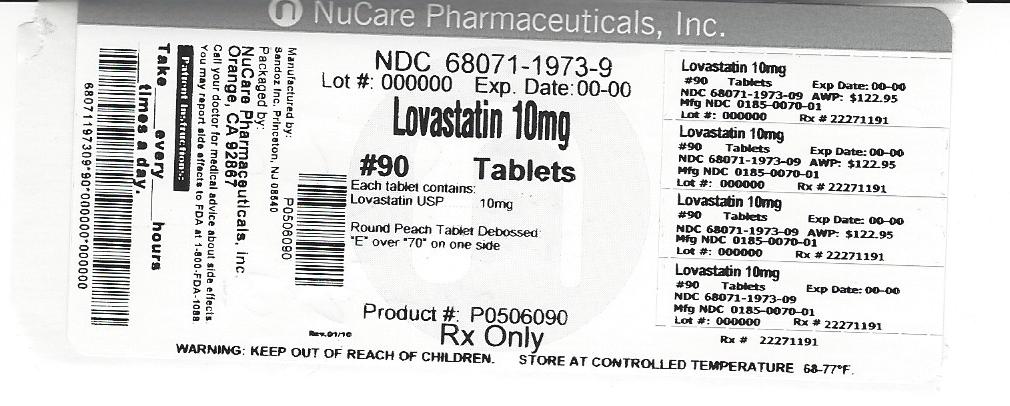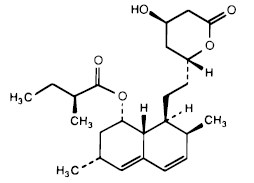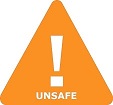American Academy of Pediatrics and other medical experts exclusively recommend to breastfeed the baby for first 6 months. Once you introduce baby to other foods it is recommended to breastfeed for at least first year of babys life. Taking medication while breastfeeding could be tricky as most drugs pass in breast milk. In this article we will evaluate Lovastatin 30 In 1 Bottle for its safety in breastfeeding.
What is Lovastatin 30 In 1 Bottle used for?
Therapy with lovastatin tablets USP should be a component of multiple risk factor intervention in those individuals with dyslipidemia at risk for atherosclerotic vascular disease. Lovastatin tablets USP should be used in addition to a diet restricted in saturated fat and cholesterol as part of a treatment strategy to lower total-C and LDL-C to target levels when the response to diet and other nonpharmacological measures alone has been inadequate to reduce risk. Primary Prevention of Coronary Heart Disease In individuals without symptomatic cardiovascular disease, average to moderately elevated total-C and LDL-C, and below average HDL-C, lovastatin tablets USP are indicated to reduce the risk of: - Myocardial infarction - Unstable angina - Coronary revascularization procedures (See CLINICAL PHARMACOLOGY, Clinical Studies) Coronary Heart Disease Lovastatin tablets USP are indicated to slow the progression of coronary atherosclerosis in patients with coronary heart disease as part of a treatment strategy to lower total-C and LDL-C to target levels. Hypercholesterolemia Therapy with lipid-altering agents should be a component of multiple risk factor intervention in those individuals at significantly increased risk for atherosclerotic vascular disease due to hypercholesterolemia. Lovastatin tablets USP are indicated as an adjunct to diet for the reduction of elevated total-C and LDL-C levels in patients with primary hypercholesterolemia (Types IIa and IIb 2), when the response to diet restricted in saturated fat and cholesterol and to other nonpharmacological measures alone has been inadequate. ____________________________________________________ 2Classification of Hyperlipoproteinemias Lipid Elevations Type Lipoproteins Elevated Major Minor I chylomicrons TG ↑→C IIa LDL C − IIb LDL, VLDL C TG III (rare) IDL C/TG − IV VLDL TG ↑→C V (rare) chylomicrons, VLDL TG ↑→C IDL = intermediate-density lipoprotein. Adolescent Patients with Heterozygous Familial Hypercholesterolemia Lovastatin tablets USP are indicated as an adjunct to diet to reduce total-C, LDL-C and apolipoprotein B levels in adolescent boys and girls who are at least one year post-menarche, 10 to 17 years of age, with heFH if after an adequate trial of diet therapy the following findings are present: 1. LDL-C remains >189 mg/dL or 2. LDL-C remains >160 mg/dL and: •there is a positive family history of premature cardiovascular disease or two or more other CVD risk factors are present in the adolescent patient General Recommendations Prior to initiating therapy with lovastatin tablets USP, secondary causes for hypercholesterolemia (e.g., poorly controlled diabetes mellitus, hypothyroidism, nephrotic syndrome, dysproteinemias, obstructive liver disease, other drug therapy, alcoholism) should be excluded, and a lipid profile performed to measure total-C, HDL-C, and TG. For patients with TG less than 400 mg/dL (<4.5 mmol/L), LDL-C can be estimated using the following equation: LDL-C = total-C - [0.2 x (TG) + HDL-C] For TG levels >400 mg/dL (>4.5 mmol/L), this equation is less accurate and LDL-C concentrations should be determined by ultracentrifugation. In hypertriglyceridemic patients, LDL-C may be low or normal despite elevated total-C. In such cases, lovastatin tablets USP are not indicated. The National Cholesterol Education Program (NCEP) Treatment Guidelines are summarized below: NCEP Treatment Guidelines: LDL-C Goals and Cutpoints for Therapeutic Lifestyle Changes and Drug Therapy in Different Risk Categories Risk Category LDL Goal (mg/dL) LDL Level at Which to Initiate Therapeutic Lifestyle Changes (mg/dL) LDL Level at Which to Consider Drug Therapy (mg/dL) CHD CHD, coronary heart diseaseor CHD risk equivalents (10-year risk >20%) <100 ≥100 ≥130 (100-129: drug optional) Some authorities recommend use of LDL-lowering drugs in this category if an LDL-C level of <100 mg/dL cannot be achieved by therapeutic lifestyle changes. Others prefer use of drugs that primarily modify triglycerides and HDL-C, e.g., nicotinic acid or fibrate. Clinical judgment also may call for deferring drug therapy in this subcategory. 2+ Risk factors (10-year risk ≤20%) <130 ≥130 10-year risk 10-20%: ≥130 10-year risk <10%: ≥160 0-1 Risk factor Almost all people with 0-1 risk factor have a 10-year risk <10%; thus, 10-year risk assessment in people with 0-1 risk factor is not necessary. <160 ≥160 ≥190 (160-189: LDL-lowering drug optional) After the LDL-C goal has been achieved, if the TG is still >200 mg/dL, non HDL-C (total-C minus HDL-C) becomes a secondary target of therapy. Non-HDL-C goals are set 30 mg/dL higher than LDL-C goals for each risk category. At the time of hospitalization for an acute coronary event, consideration can be given to initiating drug therapy at discharge if the LDL-C is >130 mg/dL (see NCEP Guidelines above). Since the goal of treatment is to lower LDL-C, the NCEP recommends that LDL-C levels be used to initiate and assess treatment response. Only if LDL-C levels are not available, should the total-C be used to monitor therapy. Although lovastatin tablets USP may be useful to reduce elevated LDL-C levels in patients with combined hypercholesterolemia and hypertriglyceridemia where hypercholesterolemia is the major abnormality (Type IIb hyperlipoproteinemia), it has not been studied in conditions where the major abnormality is elevation of chylomicrons, VLDL or IDL (i.e., hyperlipoproteinemia types I, III, IV, or V). 2 2 Classification of Hyperlipoproteinemias The NCEP classification of cholesterol levels in pediatric patients with a familial history of hypercholesterolemia or premature cardiovascular disease is summarized below: Category Total-C (mg/dL) LDL-C (mg/dL) Acceptable <170 <110 Borderline 170 to 199 110 to 129 High ≥200 ≥130 Children treated with lovastatin in adolescence should be re-evaluated in adulthood and appropriate changes made to their cholesterol-lowering regimen to achieve adult goals for LDL-C.
I am breastfeeding mother and I am using Lovastatin 30 In 1 Bottle. Can it have any bad effect on my kid? Shall I search for better alternative?
As Lovastatin 30 In 1 Bottle is made of only Lovastatin, and Lovastatin is unsafe to use in breastfeeding we can safely reach on conclusion that Lovastatin 30 In 1 Bottle is also unsafe to use while breastfeeding. Below is detailed analysis of Lovastatin and Lovastatin 30 In 1 Bottle during location. We recommend you to go through provided detailed analysis as below take decision accordingly. We also recommend you talk to your health care provider before making final decision.
Statement of Manufacturer/Labeler about breastfeeding usage
Nursing Mothers It is not known whether lovastatin is excreted in human milk. Because a small amount of another drug in this class is excreted in human breast milk and because of the potential for serious adverse reactions in nursing infants, women taking lovastatin should not nurse their infants (see CONTRAINDICATIONS ).
Lovastatin 30 In 1 Bottle Breastfeeding Analsys
UnsafeCAS Number: 75330-75-5
Statin drugs do its action by inhibiting cholesterol synthesis. On latest update relevant data on breastfeeding was not found. Its high plasma protein binding makes excretion into breast milk unlikely. Ability to alter fat composition of breast milk is unknown which is important since infants are in need of high amounts of cholesterol for adequate brain development, cell membrane building and hormone and vitamin synthesis. Avoid taking it at least while exclusive breastfeeding. Atorvastatin is possibly the safest statin drug because a higher molecular weight that lowers excretion into breast milk even more extensively. For Pravastatin a minimal excretion has been reported. Simvastatin has a lowest oral bioavailability. Avoiding drug treatment for cholesterol as long as breastfeeding is desired would probably not harm long term result of disease. Continuing with a low fat containing diet is recommended.
Lovastatin 30 In 1 Bottle Breastfeeding Analsys - 2
CAS Number: 75330-75-5

No relevant published information exists on the use of lovastatin during breastfeeding. Because of a concern with disruption of infant lipid metabolism, the consensus is that lovastatin should not be used during breastfeeding. However, others have argued that children homozygous for familial hypercholesterolemia are treated with statins beginning at 1 year of age, that statins have low oral bioavailability, and risks to the breastfed infant are low, especially with rosuvastatin and pravastatin.[1] Until more data become available, an alternate drug may be preferred, especially while nursing a newborn or preterm infant.

I already used Lovastatin 30 In 1 Bottle and meanwhile I breastfed my baby should I be concerned?
If you observer abnormal behavior or any other health issue in infant then you should immediately call 911 or contact other contact other emergency service provider in your area otherwise closely monitor the baby and inform your doctor about your Lovastatin 30 In 1 Bottle usage and time interval of breastfeeding.
I am nursing mother and my doctor has suggested me to use Lovastatin 30 In 1 Bottle, is it safe?
If your doctor knows that you are breastfeeding mother and still prescribes Lovastatin 30 In 1 Bottle then there must be good reason for that as Lovastatin 30 In 1 Bottle is considered unsafe, It usually happens when doctor finds that overall advantage of taking outweighs the overall risk.
If I am using Lovastatin 30 In 1 Bottle, will my baby need extra monitoring?
Yes, Extra monitoring is required if mother is using Lovastatin 30 In 1 Bottle and breastfeeding as it is considered unsafe for baby.
Who can I talk to if I have questions about usage of Lovastatin 30 In 1 Bottle in breastfeeding?
US
National Womens Health and Breastfeeding Helpline: 800-994-9662 (TDD 888-220-5446) 9 a.m. and 6 p.m. ET, Monday through Friday
UK
National Breastfeeding Helpline: 0300-100-0212 9.30am to 9.30pm, daily
Association of Breastfeeding Mothers: 0300-330-5453
La Leche League: 0345-120-2918
The Breastfeeding Network supporter line in Bengali and Sylheti: 0300-456-2421
National Childbirth Trust (NCT): 0300-330-0700
Australia
National Breastfeeding Helpline: 1800-686-268 24 hours a day, 7 days a week
Canada
Telehealth Ontario for breastfeeding: 1-866-797-0000 24 hours a day, 7 days a week




